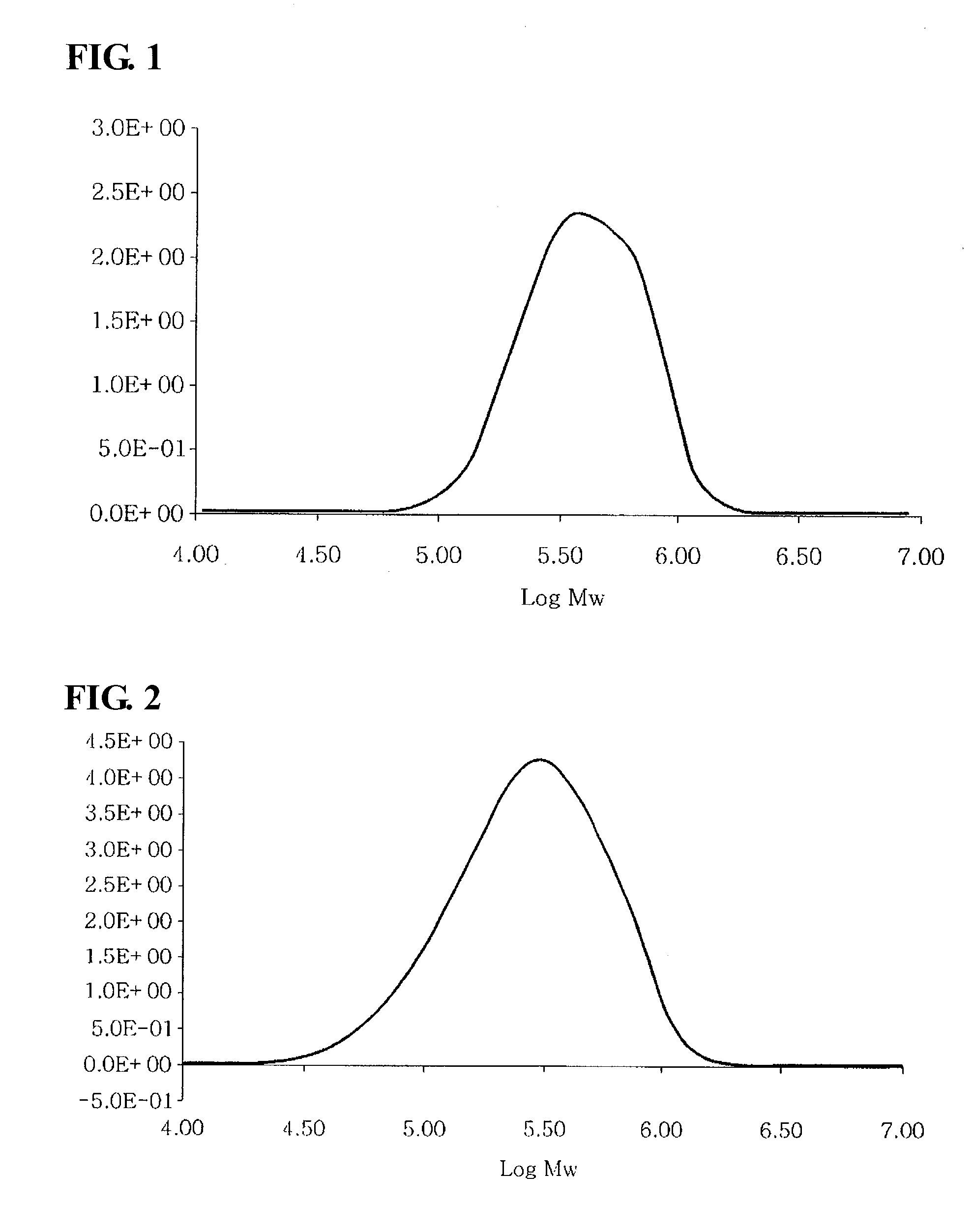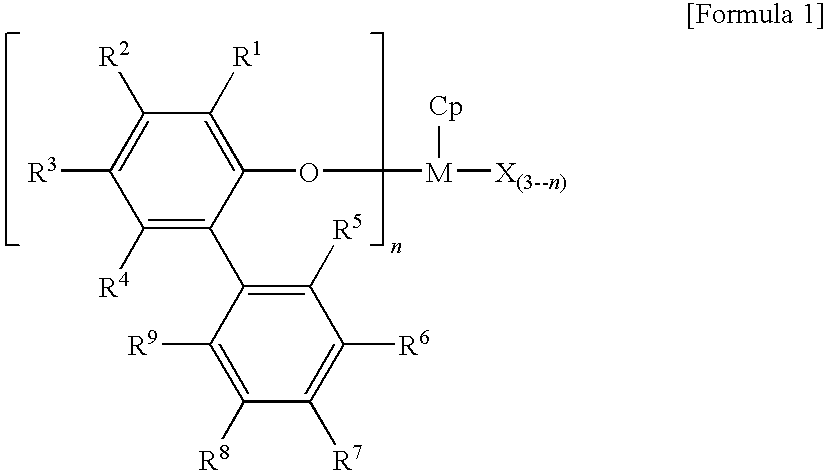Ethylene copolymer having multiple pitch molecular weight distribution and the method of preparing the same
a technology of molecular weight distribution and ethylene copolymer, which is applied in the direction of thin material processing, transportation and packaging, etc., can solve the problems of difficulty in ethylene copolymer resin production for use in various applications, limitation of ethylene copolymer physical properties through improving the process, and inability to achieve the effect of improving the product performance and value, excellent processability and physical properties
- Summary
- Abstract
- Description
- Claims
- Application Information
AI Technical Summary
Benefits of technology
Problems solved by technology
Method used
Image
Examples
preparation example 1
Synthesis of bis(pentamethylcyclopentadienyl)(2-phenyl-4-fluorophenoxy)titanium (IV) chloride
[0088]1.90 g (10.09 mmol) of 2-phenyl-4-fluorophenol was dissolved in 80 ml of diethylether, and 4.8 ml of butyl lithium (2.5 M hexane solution) was slowly added dropwise thereto at 0° C. The mixture was allowed to react at room temperature for 5 hours, and then a solution of trichloro(pentamethylcyclopentadienyl)titanium (IV) (1.64 g, 5.5 mmol) in 10 ml of diethyl ether was slowly added dropwise thereto at −78° C. The reaction product was stirred at room temperature for 12 hours and filtered, and then volatile materials were removed therefrom. The residue was recrystallized from a mixed solvent of toluene / hexane at −35° C., thus obtaining 2.54 g of a orange-colored solid.
[0089]Yield: 85%.
[0090]1H NMR (C6D6): 1.46 (s, 15H), 6.65-7.57 (m, 8H).
preparation example 2
Synthesis of bis(4-methyl-2-(2′-isopropylphenyl)phenoxy)(pentamethylcyclopentadienyl)titanium (IV) chloride
[0091]2 g (8.8 mmol) of 4-methyl-2-(2′-isopropylphenyl)phenol and 636 mg (26.5 mmol) of sodium hydride were dissolved in 20 ml of toluene, and then refluxed for 4 hours. The refluxed solution was cooled to room temperature, and then a solution of 1.15 g (4.0 mmol) of (pentamethylcyclopentadienyl) titanium (IV) trichloride in 5 ml of toluene was slowly added dropwise thereto, and the mixture solution was refluxed for 24 hours. After completion of the reaction, volatile materials were removed therefrom, and the residue was washed with purified hexane, and then recrystallized from hexane at −35° C. The resulting material was filtered and then dried in a vacuum, thus obtaining 1.65 g of an orange-colored solid.
[0092]Yield: 61%.
[0093]1H NMR (C6D6): δ=0.96-1.07 (m, 6H), 1.54 (s, 15H), 1.72 (s, 3H), 2.76 (m, 1H), 6.76-7.27 (m, 7H) ppm
preparation example 3
Synthesis of bis(2-phenylphenoxy)(pentamethylcyclopentadienyl)titanium (IV) chloride
[0094]1.72 g (10.1 mmol, 99%) of 2-phenylphenol (Aldrich) was placed in a dried flask and dissolved in 40 ml of toluene, and then the solution was cooled to 0° C. with constant stirring. 4.8 ml of N-butyl lithium (2.5 M hexane solution, Aldrich) was slowly added dropwise to the mixture. After completion of the dropwise addition, the mixture was left to stand for 1 hour, and then a solution of 1.64 g (5.5 mmol) of pentamethylcyclopentadienyl titanium trichloride in 10 ml of toluene was slowly added dropwise thereto. After completion of the dropwise addition, the mixture was left to stand for 1 hour, and then warmed to room temperature and stirred again for 1 hour. After the temperature of the reactor was increased to 90° C., the mixture was allowed to react for 12 hours. The reaction product was filtered, and then volatile materials were removed therefrom. The residue was recrystallized from a mixed s...
PUM
| Property | Measurement | Unit |
|---|---|---|
| temperature | aaaaa | aaaaa |
| temperature | aaaaa | aaaaa |
| temperature | aaaaa | aaaaa |
Abstract
Description
Claims
Application Information
 Login to View More
Login to View More - R&D
- Intellectual Property
- Life Sciences
- Materials
- Tech Scout
- Unparalleled Data Quality
- Higher Quality Content
- 60% Fewer Hallucinations
Browse by: Latest US Patents, China's latest patents, Technical Efficacy Thesaurus, Application Domain, Technology Topic, Popular Technical Reports.
© 2025 PatSnap. All rights reserved.Legal|Privacy policy|Modern Slavery Act Transparency Statement|Sitemap|About US| Contact US: help@patsnap.com



